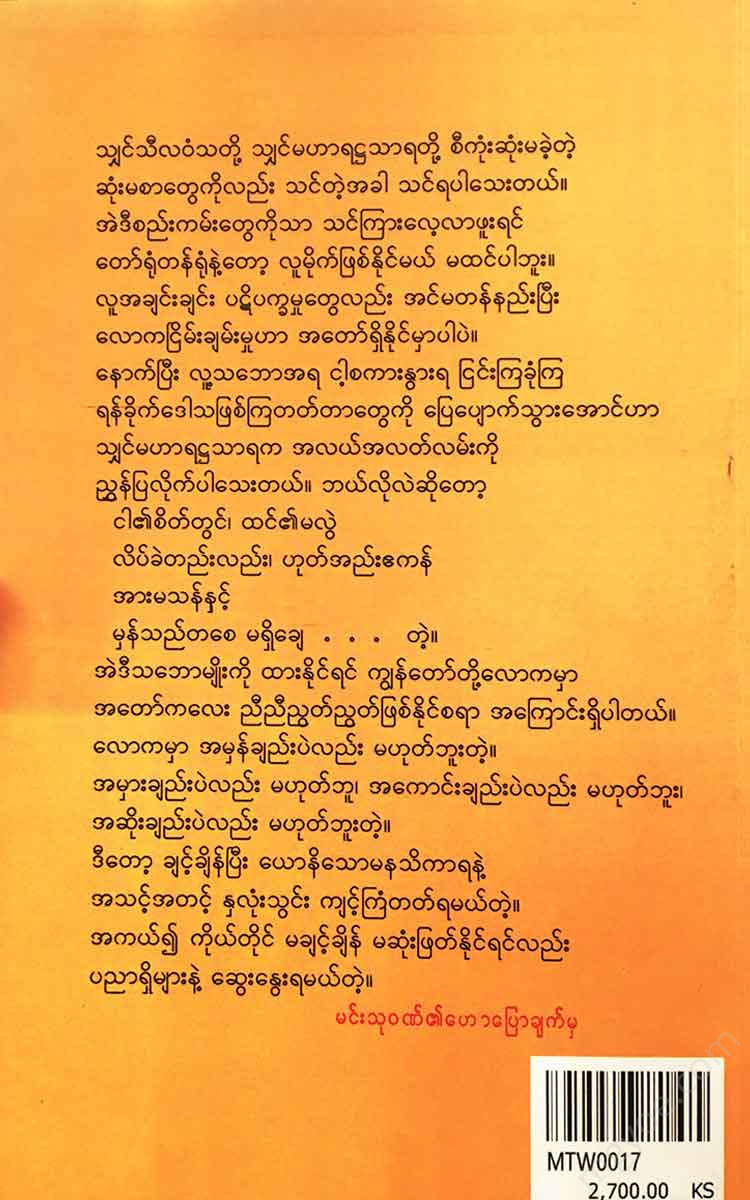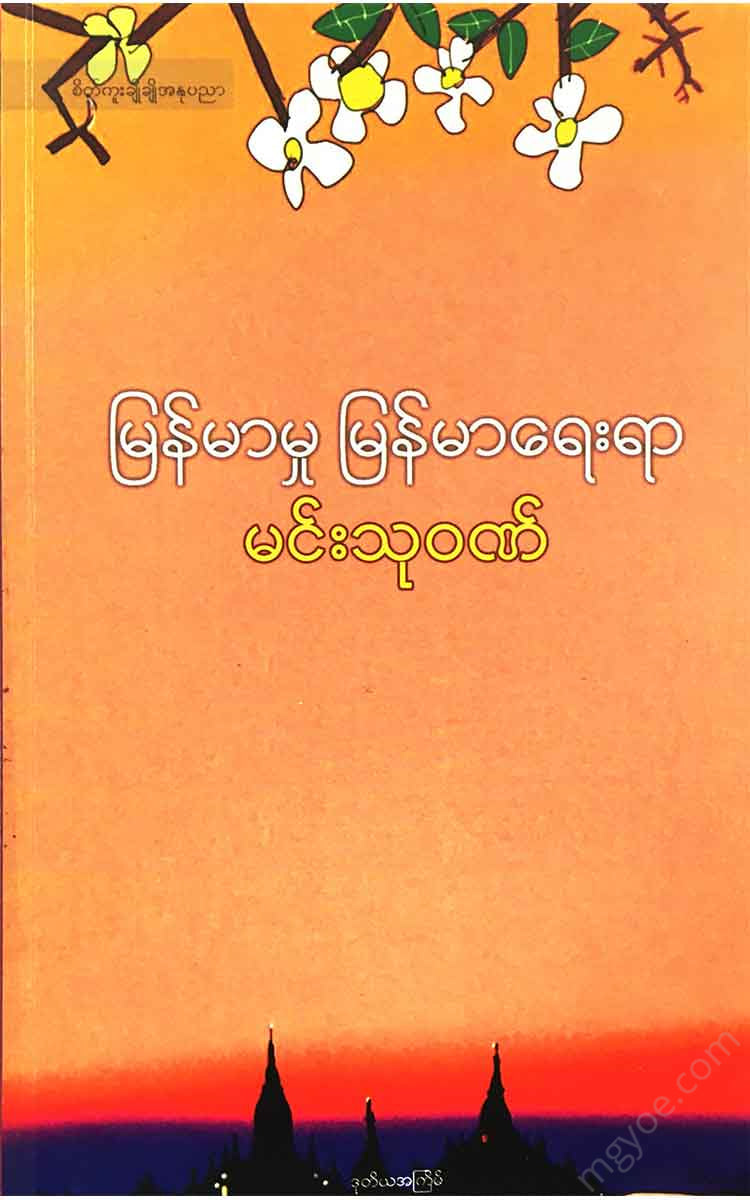စိတ်ကူးချိုချိုစာပေ
Min Thuwan - Myanmar Affairs
Min Thuwan - Myanmar Affairs
Couldn't load pickup availability
Zen Buddhism and Japanese Culture
Many scholars have written about how important Zen Buddhism was in creating the unique character of the Japanese people. The influence of Zen is pervasive in all aspects of Japanese culture. In the arts such as painting, architecture, and poetry, in the martial arts such as spear-making, sword-making, shield-making, and armor-making, and in the worldly customs such as the tea ceremony, the influence and taste of Zen can be clearly felt. Zen is the great source of water for the Japanese people, who are now a major force in the world.
Let me tell you a little about the Dhamma of Buddhism. Dhamma is a difficult religion to understand. The wise say that it is difficult for those who have not attained the foundation of Dhamma to understand. It seems that we can only guess and think by looking at the signs (this is what Dhamma thinks). Let me continue to write and make these signs clear.
Zen Buddhism is a branch of the northern branch of Buddhism called Mahayana. In 600 AD, a monk from India, known as the Buddha, came to China to preach and establish Zen Buddhism. Around 800 AD, the doctrine flourished in China and gained many disciples and spread to the Japanese islands. From China, it spread to the Japanese islands.
According to a Japanese scholar, Zen Buddhism was developed in India, Central Asia, and China by monks who were disciples of God.
It is a doctrine that removes the barriers of false teachings and teaches directly the fundamental law of God.
A saying by the Chinese sage Fa Yin (Go So Ho Yin) regarding Zen is worth noting, and will be explained in detail below.
You may ask me what analogy Zen is like. I would say that Zen is like learning to steal. In the past, the son of a great thief saw that his father was old and infirm, and if he could not steal to feed his old father, our family would starve. I learned to steal.
Thinking that he would be killed, he informed his father. At that time, the father took his son to a house. He broke open the fence. After entering the house, he opened a large box and asked his son to enter the box and steal the goods. As soon as the son-in-law entered the box, the thief closed the box, locked it, and after knocking loudly to wake up the family, he left for the courtyard. The family got up in a panic and lit a lamp to search for the thief, but they did not find him. The thief, who was locked in the box, was thinking about his cruel father and was sad, when he suddenly had an idea and imitated the sound of a mouse gnawing inside the box. Then a maidservant came to open the box with a lamp, and the thief also came out of the box, blew out the lamp and ran away. The family also followed. Then the thief saw a well, and he threw a large stone into it, and ran away. A group of his pursuers, thinking that he had fallen into the well, gathered at the mouth of the well to watch. Thus the thief, having escaped from his enemies, returned home safely, and blamed his father greatly. Then the father begged him not to be angry, and said, "Tell me everything that happened." When he told them, he said, "Sadhu, sadhu, my son has mastered the art of stealing to the end."
This unique method is the Zen method. The Zen teacher does not teach his students in long, elaborate and meaningful lectures. He teaches them directly, so that they can see the light of wisdom and understand the truth. Having thus briefly explained the difficult Zen method, let us now describe the signs and symptoms of Zen.
Zen and Samurai
As the Japanese proverb says, “Tinde” is the three sects of the gods, “Shingo” is the three sects of the nobles, “Zhan” is the three sects of the warriors, and “Do” is the three sects of the common people. The samurai, the Japanese warriors, are disciples of the Zen sect. Although the law of God, full of great mercy, is in conflict with the bloody fighting and killing of the warriors, Zen philosophy contains the principles that the warriors like.
Zen is a philosophy that does not retreat. When you start a matter, you only move forward. You do not look back or sideways, but you only move forward with one mind. The motto of the Zen sect is "Go forward."
In addition, the rules and regulations of the Zen sect are not general and unusual, but very clear and straightforward. Direct and direct. Self-reliance, self-reliance, self-cultivation. Self-respect, no fear of enemies, no poverty.
The above-mentioned basic principles of Zen Buddhism are the qualities and virtues that are desirable for a warrior. The Hagakure, a Japanese document, states that a samurai warrior should not show off his own glory. He should not show off in a showy manner. He should avoid fame and should do something good for sentient beings. In this respect, Zen Buddhism and the philosophy of chivalry are in agreement.
In addition, many Japanese scholars have written extensively about the Bushido principle, which can be called the way of the samurai. Death is a serious issue for everyone. For samurai warriors, it is especially important. The life of a samurai is a life of war. War is about death, and if you don't die, you will die. If you don't kill, he will kill. For samurai who are friends with death, the book called Bushido Basics states that the most important and desirable law for a samurai warrior is death. A samurai warrior must be mindful of death day and night, from dawn to dusk, until the end of the year. A warrior who understands and realizes this law of death will be able to fulfill his duties to the end. He will respect and honor his master's loyalty. He will also fulfill his duty to his parents. Therefore, he will overcome all kinds of hardships. In this way, not only will his life be prolonged, but his honor will also increase. Human life is very short. Especially the life of a samurai is short. Therefore, a good samurai should not care about life, but only about fulfilling his duty.
This lesson is consistent with the unwavering teachings of the Zen sect, and the samurai warrior loves the Zen sect.
The book Hagakure also states that Bushido means the determination to die. When the road is at a crossroads, the samurai warrior must not hesitate to follow the path of death. Some may say that dying like this without reaching the goal is a waste of time, a dog's death. However, when you reach the end of your journey, do not try to pick flowers. It is true that everyone is afraid of death and wants to live.
If a man cannot pluck a flower while he is alive, he is a coward. But a hero cannot pluck a flower. It is a shame. To die like this may be to die like a dog, or like a fool. But there is no shame in tarnishing his honor. In Bushido, honor is important. Shame is important. Therefore, a hero must always be mindful of death. He who has made up his mind to die is a successful man in Bushido. His life is free from sin and his duties are well fulfilled.
In this way, the samurai warriors' Bushido and Zen philosophy were united in one day in not fearing death, not retreating, and working hard to benefit the world. Therefore, the samurai warriors loved Zen philosophy and bowed at the feet of Zen masters to receive their teachings.
Meditation and sword writing
The sword is the life of a samurai. When thinking about the samurai, it is impossible to ignore it. If a samurai wants to fulfill his duty as a warrior, he must be able to transcend the laws of nature and death. He must be able to ignore them. When the time comes, a warrior must not hesitate to give up his life. To give up his life means to be cut to pieces by the enemy's sword or to execute himself with his own sword. In other words, if he thinks he can defeat the enemy, he executes the enemy, and if he thinks he can defeat the enemy, he executes himself. In this way, the sword is not only closely related to the life of a samurai, but also becomes a symbol of gratitude, loyalty, respect, and selfless sacrifice.
The purpose of the sword is twofold. The first is to clear away the obstacles that block the path of the owner. The second is to clear away the attachments to the physical world and self-interest. Therefore, the first is related to patriotism and militarism, while the second is to express gratitude, loyalty, respect, and self-sacrifice. In the first case, the sword is a weapon of destruction and a symbol of strength. Sometimes it can even lead to a very cruel and brutal situation. However, if the first case is carefully guarded and the second case is carefully guarded, it can lead to a noble situation. This is because when it is guarded, destruction only becomes the destruction of evil. In this way, the sword becomes a powerful weapon to suppress and overcome those things that disturb the peace, justice, progress, and kindness of the world.
In the Nippon shrine, the deity Matsiri holds a sword in his right hand and a Sutta in his left. This deity's sword is not for killing. It is for destroying the three evils of greed, anger, and delusion, like the sword in the Shin Uttama Kyaw Tola. The sword in this way, which is included in Zen philosophy, and the sword of the heroes, are in agreement with each other, and are only for destroying the thorns and thorns that arise on the path to liberation.
Therefore, the Japanese attach great importance to swords and weapons. The process of making swords is also very simple. When a sword is to be made, the blacksmith first invites the guardian deity to the forge. Then, he blocks the forge with a rope to prevent evil spirits from entering and interfering. Then, the blacksmith takes a bath, dresses up nicely, and makes the sword. With the belief that the deity is there to protect and help, the blacksmith forges the sword in the fire, hammers it, drops it in water, and hardens it on a stone, making a noble sword for the warriors. In this way, the sword is made with great faith and trust in the deity, and the Japanese people cherish the sword very much.
A Zen master named Takon's statement about the close connection between swordplay and Zen is very noteworthy, and I will briefly describe it below.
In Buddhism, there are 52 stages of practice for the attainment of enlightenment, one of which is called the stage of cessation of attachment. When one reaches this stage, the practitioner becomes stuck and cannot move forward. This stage of cessation of attachment is similar to that of cessation of attachment in swordsmanship. In swordsmanship, if the enemy is about to strike, you concentrate your mind on the enemy's sword. Then you will fall under the enemy's power, and you will not be able to control yourself and will not be able to escape. I call this kind of concentration cessation of attachment. Otherwise, you see the sword coming towards you. You do not pay attention, nor do you think about how to handle this sword. To snatch the enemy's sword and try to strike back without any thought or care is to defeat the enemy with the enemy's weapon.
The law of victory. There is a saying in Zen Buddhism that one should take the sword of the enemy and kill him with his own sword. If one pays attention to the sword in the enemy's hand,
If you pay attention to the sword in your hand, or to time, place, or yoga, your attention is fixed, and it is like giving the enemy a good opportunity. This kind of fixedness should be avoided in Buddhism and in swordplay. This is how the Zen master Takum once wrote about the relationship between Zen and swordplay. This kind of fixedness is called bonno in the Japanese language, and it is the same as defilements in the Pali language. In the Mahayana scriptures, the Sutta of Wisdom, which contains the words: "Do not let your mind be fixed in any way."
There is a commandment that one should not be attached to anything, but should always be alert. Furthermore, when learning swordsmanship, the swordsman is called an osho and the room where the swordsman is trained is called a dojo, which clearly shows that swordsmen have learned and inherited everything from Zen Buddhism.
Regarding the sword, there are still issues such as the initial wisdom, the unmoving wisdom, and the mindless state, but I will stop this chapter with this.
Meditation and tea ceremony
You can read about tea in U Punya's Metta Sa. You can find a lot about tea in the Utu Bawjana book. The Utu Bawjana writer King Yaw Mingyin wrote a good article about tea, so a later writer who was a great lover of tea wrote about it.







